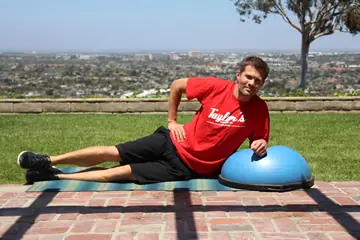The Issue: If Your Arch Flattens Out
1 of 14
The Fix for Flattened Arches
2 of 14
single-leg deadlift
Foam roll your calves and outer lower legs, and static stretch the calves and hamstrings post-workout.
Strengthening exercises: Complete 6 to 10 reps of single-leg deadlifts for 3 to 4 sets. Complete 10 to 12 reps of single-leg medial calf raises (angle your foot slightly inward) for 3 to 4 sets.
The Issue: If Your Feet Turn Out
3 of 14
The Fix for Turned-Out Feet
4 of 14
The Issue: If Your Knees Cave In
5 of 14
You are at a greater risk for an ACL injury. Your adductors, tensor fascia lata (TFL) and biceps femoris (short head of the hamstring) are overactive, and your gluteus medius and maximus, and vastus medialis oblique muscles are underactive.
The Fix for Caved-In Knees
6 of 14
Foam roll your adductors and TFL; static stretch your adductors, TFL and hamstrings post-workout.
Strengthening exercises: Complete three sets of 12 to 15 steps of lateral band walks on each side. Complete 5 to 10 reps of squats for 3 to 5 sets. Make sure to get your hip crease below 90 degrees, and don't let your knees cave in on the descent or ascent.
The Issue: Your Lower Back Over Arches
7 of 14
There is a good chance that you have tight hip flexors, which shortens your stride. The overactive muscles are the hip flexors, erector spinae and lats. The underactive muscles and the intrinsic core stabilizers and gluteus maximus.
The Fix for an Over-Arched Lower Back
8 of 14
Foam roll your hip flexors and lats. Use a lacrosse ball on your lower back (roll on both the left and right side of your spine). Static stretch your hip flexors, lats and erector spinae post-workout.
Strengthening exercises: Complete 4 to 6 sets of 15- to 45-second hold planks. Complete 3 to 5 sets of 5 to 10 reps of squats. Make sure to get your hip crease below 90 degrees, and don't let your knees cave in on the descent or ascent.
The Issue: If Your Upper Body Leans Forward
9 of 14
The Fix for a Forward-Leaning Upper Body
10 of 14
Foam roll your calves and hip flexors; static stretch your calves and hip flexors post-workout.
Strengthening exercises: Complete stability ball cobras for 3 to 4 sets of 8 to 12 reps. Complete 5 to 10 reps of squats for 3 to 5 sets. Make sure to get hip crease below 90 degrees, and don't let your knees cave in on the descent or ascent.
The Issue: Your Arms Fall Forward
11 of 14
The Fix for Forward-Falling Arms
12 of 14
Foam roll your lats, and use a lacrosse ball to roll out your chest. Static stretch your lats and chest post-workout.
Strengthening exercises: Complete stability ball cobras for 3 to 4 sets of 8 to 12 reps. Complete TRX back rows or inverted rows for 3 to 4 sets of 6 to 10 reps.
Fixing Form Takes Time
13 of 14
ideal form for the overhead squat
If you are dealing with any of these deviations, it takes patience and persistence to start seeing changes. Creating a balanced, aligned body takes persistence, but you'll reduce your chance of injury, and your body will feel so much better.
Get ACTIVE on the Go


Couch to 5K®
The best way to get new runners off the couch and across the finish line of their first 5K.
Available for iOS | Android






Discuss This Article